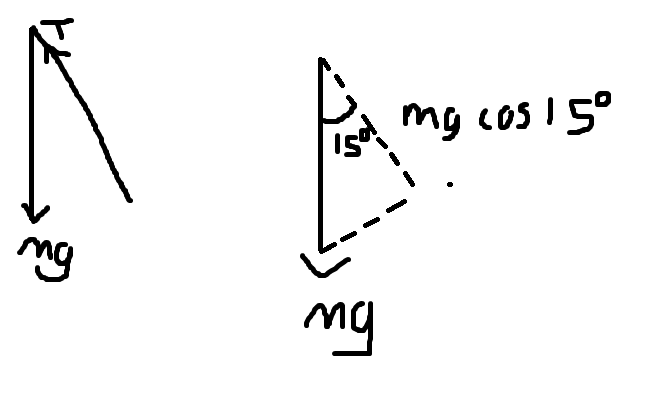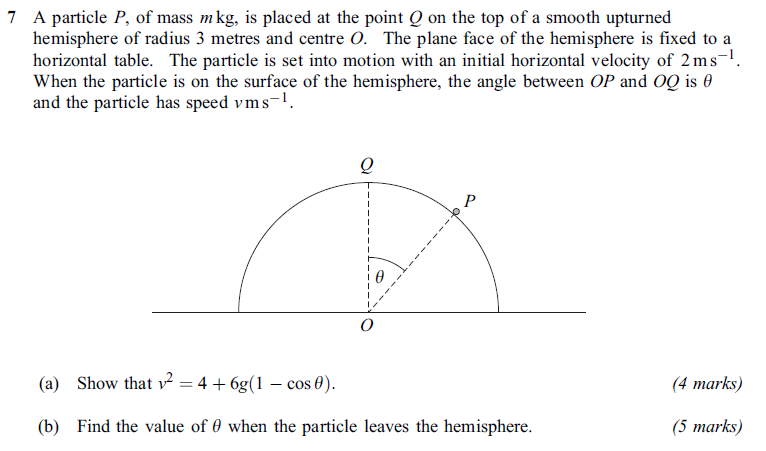AQA M2- June 2011
Scroll to see replies
Thanks.
June 10, can anyone help me with 8b. I don't understand why the markscheme says T=mgcos (15). And not T cos (15) =mg. How can the weight of the object be acting horizontally?
http://store.aqa.org.uk/qual/gce/pdf/AQA-MM2B-W-QP-JUN10.PDF
June 10, can anyone help me with 8b. I don't understand why the markscheme says T=mgcos (15). And not T cos (15) =mg. How can the weight of the object be acting horizontally?
http://store.aqa.org.uk/qual/gce/pdf/AQA-MM2B-W-QP-JUN10.PDF
I can see it. Try not to think of ' cos ' as meaning horizontally all the time. It does in some cases but here it would'nt end up that way.
If you remember your trig you know Cos(x) = a/h
Now in this example the mg is acting downward and in order to form an equation with T you need mg acting in the same direction as T.
Can you see that T acts along the hypotenuse of part of the triangle ?
And can you also see that mg acts in the same direction as the adjacent ( directly down).
If it helps you then have a diagram where T is along the hypotenuse and mg is along the adjacent ( which you can do because they are both directly down)
Then its easy to see that to get mg acting in the same direction as T you must have
Cos (x) = a/h
Cos (x) = mg/T
mg cos (x) = T
and yeh x = 15.
Hope that helps.
If you remember your trig you know Cos(x) = a/h
Now in this example the mg is acting downward and in order to form an equation with T you need mg acting in the same direction as T.
Can you see that T acts along the hypotenuse of part of the triangle ?
And can you also see that mg acts in the same direction as the adjacent ( directly down).
If it helps you then have a diagram where T is along the hypotenuse and mg is along the adjacent ( which you can do because they are both directly down)
Then its easy to see that to get mg acting in the same direction as T you must have
Cos (x) = a/h
Cos (x) = mg/T
mg cos (x) = T
and yeh x = 15.
Hope that helps.
.... not that I'm doing this Q but I was following your logic until you did the equations. You couldn't get mg cos (x) = T from cos (x) = mg/T
Indeed you cant.. well thats interesting..
The logic made sense so I just assumed the equations would follow..
Well if mg is the adjacent and you have T as the hypotenuse it must be something with cos.. but equation wise it would be Tcos(x) = mg then.. but that gives you 2.168 not 2.32 which is the right answer..
hmm
and all this time iv been blindly doing T=mgcos(x) without realising it doesn't work..
how do they get it then I wonder.

painfully obvious after looking at that second diagram.. well at least you under stand
 even if I helped very little haha
even if I helped very little haha
Surely at Q it has energy 1/2*4*m + 3gm
And at P it has energy 1/2*m*v + gm(3-3cos theta)
But in the mark scheme it just has three energy terms, how come there is no GPE at the top ?

At Q it does have 3mg gpe but at P it has 3mgcos theta not mg(3-3cos theta) the 3mg comes from the gpe at Q
 does that help?
does that help?the specimen paper will be worse then tomorrow garanteed! try a different exam board for more questions!
Yeah so then the KE at P = the KE at Q plus the lost gpe which is what they've given in the mark scheme

Yeah but if I can do the specimen I'm sorted (ish... xD)
Just about to try it

Someone kindly posted it on this thread : http://www.thestudentroom.co.uk/showthread.php?t=1682725
If anyone wants it

Just about to try it

Someone kindly posted it on this thread : http://www.thestudentroom.co.uk/showthread.php?t=1682725
If anyone wants it

Thanks
Just about to try it

Someone kindly posted it on this thread : http://www.thestudentroom.co.uk/showthread.php?t=1682725
If anyone wants it

Did you try it??
The question at the end is baffling me
 where its asks for h do you only consider energy between the top of the hill and the bottom just before the loop, does it have nothing to with loop?
where its asks for h do you only consider energy between the top of the hill and the bottom just before the loop, does it have nothing to with loop?Q. 6 a
The question at the end is baffling me
 where its asks for h do you only consider energy between the top of the hill and the bottom just before the loop, does it have nothing to with loop?
where its asks for h do you only consider energy between the top of the hill and the bottom just before the loop, does it have nothing to with loop?Yeah
 the energy at the top of the hill must equal the energy at the bottom of the loop as none is lost, yes this does still equal the energy at the top of the loop too but you don't need that to work out h. Hope that helps!
the energy at the top of the hill must equal the energy at the bottom of the loop as none is lost, yes this does still equal the energy at the top of the loop too but you don't need that to work out h. Hope that helps!Quick Reply
Related discussions
- GCSE Exam Discussions 2024
- A-level Exam Discussions 2024
- Over 500 questions on AQA Bio Unit 4 + Current Spec and old Spec papers + MS!
- Further Maths! M1 and M2
- people who have done/are doing A-level biology with eduqas is it bad?
- A Level Exam Discussions 2023
- GCSE Exam Discussions 2023
- gcse French speaking aqa
- PSYB4 JUN11 mark scheme?
- GCSE Biology Study Group 2022-2023
- AQA A Level Law Paper 2 (7162/2) - 4th June 2024 [Exam Chat]
- AQA A Level Politics Paper 2 (7152/2) - 5th June 2024 [Exam Chat]
- Meanings and representations english lang
- How do stay on topic in the French GCSE 150 word question?
- AQA A Level Politics Paper 3 (7152/3) - 14th June 2024 [Exam Chat]
- AQA GCSE Physics Paper 2 (Foundation Combined) 8464/2F - 16th June 2023 [Exam Chat]
- AQA GCSE Chemistry Paper 2 Foundation Triple (8462 2F) - 11th June 2024 [Exam Chat]
- AQA GCSE Combined Science Paper 2 Foundation (8464/C/2F) - 13th June 2023 [Exam Chat]
- AQA A Level Geography Paper 2 (7037/2) - 3rd June 2024 [Exam Chat]
- GCSE 2024 timetable
Latest
Trending
Last reply 1 day ago
Edexcel A Level Mathematics Paper 1 (9MA0 01) - 4th June 2024 [Exam Chat]Last reply 6 days ago
Edexcel IGCSE Higher tier Mathematics A Paper 1 1H (4MA1) - 8th November 2023Last reply 1 month ago
Edexcel GCSE Mathematics Paper 3 (1MA1 3) - 13th November 2023 [Exam Chat]Last reply 1 month ago
Edexcel GCSE Statistics Paper 1 Higher Tier (1ST0 1H) - 12th June 2023 [Exam Chat]284
Last reply 1 month ago
Edexcel A Level Mathematics Paper 1 (9MA0 01) - 6th June 2023 [Exam Chat]2960
Last reply 1 month ago
AQA A Level Mathematics Paper 1 (7357/1) - 6th June 2023 [Exam Chat]352
Last reply 2 months ago
Edexcel GCSE Mathematics Paper 2 (1MA1 2) - 10th November 2023 [Exam Chat]Last reply 2 months ago
Edexcel A-level Mathematics Paper 1 [6th June 2023] Unofficial Markscheme156
Last reply 2 months ago
Edexcel GCSE Mathematics Paper 1 (1MA1 1) - 8th November 2023 [Exam Chat]Last reply 3 months ago
Edexcel IGCSE Higher tier Mathematics A Paper 1 1H (4MA1) - 19th May 2023 [Exam Chat]232
Last reply 3 months ago
AQA GCSE Mathematics Paper 3 (Higher) 8300/3H - 14th June 2023 [ Exam Chat]247
Last reply 5 months ago
Edexcel IGCSE Higher tier Mathematics A Paper 2 2H (4MA1) - 10th November 2023Last reply 8 months ago
OCR A-level Mathematics A Paper 3 (H240/03) - 20th June 2023 [Exam Chat]169
Last reply 8 months ago
AQA Level 2 Further Maths 2023 Paper 1 (8365/1) & Paper 2 (8365/2) [Exam Chat]489
Last reply 8 months ago
Edexcel A Level Mathematics Paper 3 (9MA0 03) - 20th June 2023 [Exam Chat]1836
Last reply 8 months ago
AQA A Level Mathematics Paper 3 (7357/3) - 20th June 2023 [Exam Chat]307
Last reply 8 months ago
OCR A-level Mathematics B Paper 3 (H640/03) - 20th June 2023 [Exam Chat]132
Last reply 9 months ago
Edexcel A-level Further Mathematics Paper 1 (9FM0 01) - 25th May 2023 [Exam Chat]902
Trending
Last reply 1 day ago
Edexcel A Level Mathematics Paper 1 (9MA0 01) - 4th June 2024 [Exam Chat]Last reply 6 days ago
Edexcel IGCSE Higher tier Mathematics A Paper 1 1H (4MA1) - 8th November 2023Last reply 1 month ago
Edexcel GCSE Mathematics Paper 3 (1MA1 3) - 13th November 2023 [Exam Chat]Last reply 1 month ago
Edexcel GCSE Statistics Paper 1 Higher Tier (1ST0 1H) - 12th June 2023 [Exam Chat]284
Last reply 1 month ago
Edexcel A Level Mathematics Paper 1 (9MA0 01) - 6th June 2023 [Exam Chat]2960
Last reply 1 month ago
AQA A Level Mathematics Paper 1 (7357/1) - 6th June 2023 [Exam Chat]352
Last reply 2 months ago
Edexcel GCSE Mathematics Paper 2 (1MA1 2) - 10th November 2023 [Exam Chat]Last reply 2 months ago
Edexcel A-level Mathematics Paper 1 [6th June 2023] Unofficial Markscheme156
Last reply 2 months ago
Edexcel GCSE Mathematics Paper 1 (1MA1 1) - 8th November 2023 [Exam Chat]Last reply 3 months ago
Edexcel IGCSE Higher tier Mathematics A Paper 1 1H (4MA1) - 19th May 2023 [Exam Chat]232
Last reply 3 months ago
AQA GCSE Mathematics Paper 3 (Higher) 8300/3H - 14th June 2023 [ Exam Chat]247
Last reply 5 months ago
Edexcel IGCSE Higher tier Mathematics A Paper 2 2H (4MA1) - 10th November 2023Last reply 8 months ago
OCR A-level Mathematics A Paper 3 (H240/03) - 20th June 2023 [Exam Chat]169
Last reply 8 months ago
AQA Level 2 Further Maths 2023 Paper 1 (8365/1) & Paper 2 (8365/2) [Exam Chat]489
Last reply 8 months ago
Edexcel A Level Mathematics Paper 3 (9MA0 03) - 20th June 2023 [Exam Chat]1836
Last reply 8 months ago
AQA A Level Mathematics Paper 3 (7357/3) - 20th June 2023 [Exam Chat]307
Last reply 8 months ago
OCR A-level Mathematics B Paper 3 (H640/03) - 20th June 2023 [Exam Chat]132
Last reply 9 months ago
Edexcel A-level Further Mathematics Paper 1 (9FM0 01) - 25th May 2023 [Exam Chat]902




